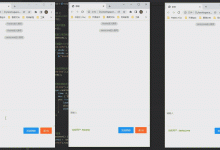— 以下内容均基于2.1.8.RELEASE版本
紧接着上一篇(二)SpringBoot启动过程的分析-环境信息准备,本文将分析环境准备完毕之后的下一步操作:ApplicationContext的创建。
创建指定类型的应用程序上下文容器
// SpringApplication.javaConfigurableApplicationContext context = createApplicationContext();protected ConfigurableApplicationContext createApplicationContext() {// ①Class<?> contextClass = this.applicationContextClass;if (contextClass == null) {try {switch (this.webApplicationType) {case SERVLET:// ②contextClass = Class.forName(DEFAULT_SERVLET_WEB_CONTEXT_CLASS);break;case REACTIVE:// ③contextClass = Class.forName(DEFAULT_REACTIVE_WEB_CONTEXT_CLASS);break;default:// ④contextClass = Class.forName(DEFAULT_CONTEXT_CLASS);}}catch (ClassNotFoundException ex) {throw new IllegalStateException("Unable create a default ApplicationContext, " + "please specify an ApplicationContextClass", ex);}}// ⑤return (ConfigurableApplicationContext) BeanUtils.instantiateClass(contextClass);}
创建ApplicationContext时可以指定需要创建的上下文类型,默认是根据当前应用类型来创建。在SpringApplication.java中指定了几种默认类型,他们分别是默认的非Web应用上下文容器、默认的Web应用上下文容器和响应式Web上下文容器
public static final String DEFAULT_CONTEXT_CLASS = "org.springframework.context." + "annotation.AnnotationConfigApplicationContext";public static final String DEFAULT_SERVLET_WEB_CONTEXT_CLASS = "org.springframework.boot." + "web.servlet.context.AnnotationConfigServletWebServerApplicationContext";public static final String DEFAULT_REACTIVE_WEB_CONTEXT_CLASS = "org.springframework." + "boot.web.reactive.context.AnnotationConfigReactiveWebServerApplicationContext";
① – 是否有指定的ApplicationContext,若有直接实例化② – 实例化Web应用上下文容器③ – 实例化响应式Web应用上下文容器④ – 实例化非Web应用上下文容器⑤ – 使用无参构造函数对指定的上下文容器进行实例化
AnnotationConfigServletWebServerApplicationContext
对于常规的以SpringBoot开发的web应用来说,AnnotationConfigServletWebServerApplicationContext将会是默认的上下文容器。它可以解析@Configuration等JSR-330定义的注解,查看它的包路径,可以看到,它是属于SpringBoot下的上下文容器。
public class AnnotationConfigServletWebServerApplicationContext extends ServletWebServerApplicationContext implements AnnotationConfigRegistry {private final AnnotatedBeanDefinitionReader reader;private final ClassPathBeanDefinitionScanner scanner;private final Set<Class<?>> annotatedClasses = new LinkedHashSet<>();private String[] basePackages;public AnnotationConfigServletWebServerApplicationContext() {// ①this.reader = new AnnotatedBeanDefinitionReader(this);// ②this.scanner = new ClassPathBeanDefinitionScanner(this);}}
① – 构造AnnotatedBeanDefinitionReader,传入当前对象作为Bean注册器② – 构造ClassPathBeanDefinitionScanner,传入当前对象作为Bean注册器
它内部的无参构造方法就干了两件事:初始化reader和scanner。他们两个的存在使当前的上下文容器支持以带有@Configuration注解的类作为加载Bean入口,也支持以指定的basePackage来作为加载Bean的入口,同时还支持注解的过滤。
上下文容器重要成员之 AnnotatedBeanDefinitionReader
用编程方式注册带注解的Bean到容器中,也就是基于注解配置的Bean的注册。
public class AnnotatedBeanDefinitionReader {// ①private final BeanDefinitionRegistry registry;// ②private BeanNameGenerator beanNameGenerator = new AnnotationBeanNameGenerator();// ③private ScopeMetadataResolver scopeMetadataResolver = new AnnotationScopeMetadataResolver();// ④private ConditionEvaluator conditionEvaluator;// ⑤public AnnotatedBeanDefinitionReader(BeanDefinitionRegistry registry) {this(registry, getOrCreateEnvironment(registry));}// ...省略部分代码}
① – BeanDefinition注册器② – BeanName生成器③ – Bean的作用域元数据解析器④ – 条件注解评估器,用于判断是否跳过被条件注解修饰的类的加载⑤ – 通过Bean注册器来构造Reader
注册内定的PostProcessor
在初始化AnnotatedBeanDefinitionReader的时候,将一些用于作基础处理的类处理器优先注册到容器内部,不太明白也没关系,照着代码看下去,看完几个就明白是干什么的了。
public AnnotatedBeanDefinitionReader(BeanDefinitionRegistry registry, Environment environment) {Assert.notNull(registry, "BeanDefinitionRegistry must not be null");Assert.notNull(environment, "Environment must not be null");this.registry = registry;this.conditionEvaluator = new ConditionEvaluator(registry, environment, null);// 注册一些固定的内部指定的类到容器中AnnotationConfigUtils.registerAnnotationConfigProcessors(this.registry);}public static void registerAnnotationConfigProcessors(BeanDefinitionRegistry registry) {registerAnnotationConfigProcessors(registry, null);}public static Set<BeanDefinitionHolder> registerAnnotationConfigProcessors( registry, @Nullable Object source) {DefaultListableBeanFactory beanFactory = unwrapDefaultListableBeanFactory(registry);if (beanFactory != null) {// ①if (!(beanFactory.getDependencyComparator() instanceof AnnotationAwareOrderComparator)) {beanFactory.setDependencyComparator(AnnotationAwareOrderComparator.INSTANCE);}// ②if (!(beanFactory.getAutowireCandidateResolver() instanceof ContextAnnotationAutowireCandidateResolver)) {beanFactory.setAutowireCandidateResolver(new ContextAnnotationAutowireCandidateResolver());}}// ③Set<BeanDefinitionHolder> beanDefs = new LinkedHashSet<>(8);if (!registry.containsBeanDefinition(CONFIGURATION_ANNOTATION_PROCESSOR_BEAN_NAME)) {RootBeanDefinition def = new RootBeanDefinition(ConfigurationClassPostProcessor.class);def.setSource(source);beanDefs.add(registerPostProcessor(registry, def, CONFIGURATION_ANNOTATION_PROCESSOR_BEAN_NAME));}if (!registry.containsBeanDefinition(AUTOWIRED_ANNOTATION_PROCESSOR_BEAN_NAME)) {RootBeanDefinition def = new RootBeanDefinition(AutowiredAnnotationBeanPostProcessor.class);def.setSource(source);beanDefs.add(registerPostProcessor(registry, def, AUTOWIRED_ANNOTATION_PROCESSOR_BEAN_NAME));}// Check for JSR-250 support, and if present add the CommonAnnotationBeanPostProcessor.if (jsr250Present && !registry.containsBeanDefinition(COMMON_ANNOTATION_PROCESSOR_BEAN_NAME)) {RootBeanDefinition def = new RootBeanDefinition(CommonAnnotationBeanPostProcessor.class);def.setSource(source);beanDefs.add(registerPostProcessor(registry, def, COMMON_ANNOTATION_PROCESSOR_BEAN_NAME));}// Check for JPA support, and if present add the PersistenceAnnotationBeanPostProcessor.if (jpaPresent && !registry.containsBeanDefinition(PERSISTENCE_ANNOTATION_PROCESSOR_BEAN_NAME)) {RootBeanDefinition def = new RootBeanDefinition();try {def.setBeanClass(ClassUtils.forName(PERSISTENCE_ANNOTATION_PROCESSOR_CLASS_NAME, AnnotationConfigUtils.class.getClassLoader()));}catch (ClassNotFoundException ex) {throw new IllegalStateException("Cannot load optional framework class: " + PERSISTENCE_ANNOTATION_PROCESSOR_CLASS_NAME, ex);}def.setSource(source);beanDefs.add(registerPostProcessor(registry, def, PERSISTENCE_ANNOTATION_PROCESSOR_BEAN_NAME));}if (!registry.containsBeanDefinition(EVENT_LISTENER_PROCESSOR_BEAN_NAME)) {RootBeanDefinition def = new RootBeanDefinition(EventListenerMethodProcessor.class);def.setSource(source);beanDefs.add(registerPostProcessor(registry, def, EVENT_LISTENER_PROCESSOR_BEAN_NAME));}if (!registry.containsBeanDefinition(EVENT_LISTENER_FACTORY_BEAN_NAME)) {RootBeanDefinition def = new RootBeanDefinition(DefaultEventListenerFactory.class);def.setSource(source);beanDefs.add(registerPostProcessor(registry, def, EVENT_LISTENER_FACTORY_BEAN_NAME));}return beanDefs;}
① – 给BeanFactory添加AnnotationAwareOrderComparator,用于处理Bean的排序② – 给BeanFactory添加ContextAnnotationAutowireCandidateResolver,用于处理@Lazy注解和@Qualifier注解③ – 注册指定的类到容器
SpringBoot默认优先注册了以下PostProcessor类,并以不同的名称来称呼这些类:左边的为BeanDefinition的名称,右边为对应的类,名称的前缀都统一是org.springframework.context.annotation
-
由Spring内部管理的用于处理配置注解的处理器internalConfigurationAnnotationProcessor -> ConfigurationClassPostProcessor.class
-
由Spring内部管理的用于处理自动装配注解的处理器internalAutowiredAnnotationProcessor -> AutowiredAnnotationBeanPostProcessor.class
-
由Spring内部管理的用于处理JSR-250注解的处理器internalCommonAnnotationProcessor -> CommonAnnotationBeanPostProcessor.class
-
由Spring内部管理的用于处理JPA注解的处理器internalPersistenceAnnotationProcessor -> PersistenceAnnotationBeanPostProcessor.class
-
由Spring内部管理的用于处理@EventListener注解的处理器internalEventListenerProcessor -> EventListenerMethodProcessor.class
-
由Spring内部管理的用于指定EventListenerFactory默认实现的类internalEventListenerFactory -> DefaultEventListenerFactory.class
其实看到这里就明白许多,单纯的就是Spring固定了一些类要首先注册进去容器,也就是在处理注解的Reader准备完毕的时候,它已经准备好了一些后续要使用的类,他们用于在不同阶段来处理不同的事情。至于注册的这些类分别可以完成什么工作,将在他们真正开始执行的时候再进行分析。至此AnnotatedBeanDefinitionReader的初始化完成了。
上下文容器重要成员之 ClassPathBeanDefinitionScanner
和上面的Reader不同的是它用于扫描类路径上的Bean,通过给定的basePackage路径来扫描类。它可以使用可配置的过滤器来检测候选类,已确定他们将是否被加载。默认的过滤器包括Spring框架的@Component、@Controller、@Service、@Repository
// 构造方法一public ClassPathBeanDefinitionScanner(BeanDefinitionRegistry registry) {this(registry, true);}// 构造方法二public ClassPathBeanDefinitionScanner(BeanDefinitionRegistry registry, boolean useDefaultFilters) {this(registry, useDefaultFilters, getOrCreateEnvironment(registry));}// 构造方法三public ClassPathBeanDefinitionScanner(BeanDefinitionRegistry registry, boolean useDefaultFilters,Environment environment) {this(registry, useDefaultFilters, environment,(registry instanceof ResourceLoader ? (ResourceLoader) registry : null));}// 构造方法四public ClassPathBeanDefinitionScanner(BeanDefinitionRegistry registry, boolean useDefaultFilters, Environment environment, @Nullable ResourceLoader resourceLoader) {Assert.notNull(registry, "BeanDefinitionRegistry must not be null");this.registry = registry;// 使用默认过滤器,从构造方法一直接传入true,代表它是默认的。if (useDefaultFilters) {// 注册默认过滤器registerDefaultFilters();}// 设置环境对象和资源加载器setEnvironment(environment);setResourceLoader(resourceLoader);}
通过多个重载的构造方法来构造ClassPathBeanDefinitionScanner对象。最后一个实际使用的构造方法传入了类注册器、是否使用默认过滤器、环境对象、资源加载器。若传入的是一个普通的BeanDefinitionRegistry(实现了BeanDefinitionRegistry接口但没有实现ResourceLoader接口的类)那么默认的资源加载器将会是org.springframework.core.io.support.PathMatchingResourcePatternResolver.
注册默认注解过滤器
为@Component注册过滤器, 还会隐式的注册@Controller、@Service、@Repository。为何说是隐式的呢?查看这几个注解便知。
@Target({ElementType.TYPE})@Retention(RetentionPolicy.RUNTIME)@Documented@Componentpublic @interface Controller {@AliasFor(annotation = Component.class)String value() default "";}@Target({ElementType.TYPE})@Retention(RetentionPolicy.RUNTIME)@Documented@Componentpublic @interface Service {@AliasFor(annotation = Component.class)String value() default "";}@Target({ElementType.TYPE})@Retention(RetentionPolicy.RUNTIME)@Documented@Componentpublic @interface Repository {@AliasFor(annotation = Component.class)String value() default "";}
他同时使用了@Component注解,并将别名设置为Component.class
// ClassPathScanningCandidateComponentProvider.javaprotected void registerDefaultFilters() {// 新增Component注解过滤器(包含Controller、Service、Repository)this.includeFilters.add(new AnnotationTypeFilter(Component.class));ClassLoader cl = ClassPathScanningCandidateComponentProvider.class.getClassLoader();try {// 如果可用的话,支持JSR-250的ManagedBean注解过滤器this.includeFilters.add(new AnnotationTypeFilter(((Class<? extends Annotation>) ClassUtils.forName("javax.annotation.ManagedBean", cl)), false));logger.trace("JSR-250 \'javax.annotation.ManagedBean\' found and supported for component scanning");}catch (ClassNotFoundException ex) {// JSR-250 1.1 API (as included in Java EE 6) not available - simply skip.}try {// 如果可用的话,支持JSR-330支持的Named注解过滤器this.includeFilters.add(new AnnotationTypeFilter(((Class<? extends Annotation>) ClassUtils.forName("javax.inject.Named", cl)), false));logger.trace("JSR-330 \'javax.inject.Named\' annotation found and supported for component scanning");}catch (ClassNotFoundException ex) {// JSR-330 API not available - simply skip.}}
总结
在上下文容器创建完毕且未刷新的情况下,内部已经优先注册了一批PostProcessor,毫无疑问,他们将会在容器接下来的操作中扮演重要角色。这里只需要理解容器在程序运行的不同阶段会有不同的执行逻辑。大概知晓它在创建的时候做了什么,在后续文章中会逐步分析。
 爱站程序员基地
爱站程序员基地


